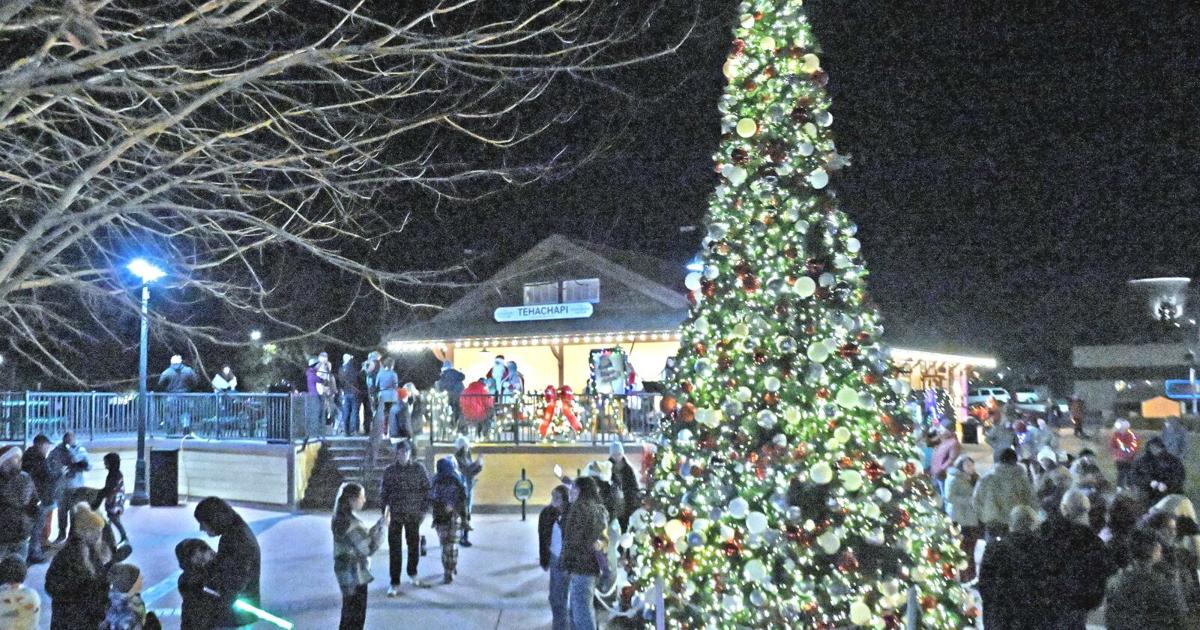
Over the past decade or so, the city of Tehachapi has provided a towering Christmas tree next to the Tehachapi Depot Railroad Museum to serve as a centerpiece for the holiday season.
A community Christmas tree has been important locally through the years, as reported by the Tehachapi News and its predecessor, The Tomahawk.
But news of the first Christmas tree was recorded in an even earlier publication known as The Weekly Gazette.
Not much is known of the Gazette, which was likely published elsewhere in Kern County with submissions by letters from residents through what was then a sparsely populated region.
The Jan. 6, 1877, edition of the Gazette included a letter signed only “Richmond” to provide news of what the writer said was the first Christmas tree in “Tehachipa,” an early spelling for the community’s name.
To put the date in perspective, consider some of this information from a Tehachapi history timeline created by Pat Gracey:
The first Fourth of July celebration in Kern County was held in Tehachapi in 1856, the same year that Squire Wiggins was the first postmaster. The post office was located at Ed Green’s General Store in what is now known as the Old Town area. The first school was conducted in the Tehachapi Valley by William Wiggins in 1861 and the Fickert family arrived in Bear Valley in 1869.
The town moved to its current location in 1876 when the railroad line opened following completion of the Tehachapi Loop and Southern Pacific Railroad built a depot.
So Christmas 1876 marked the first time the holiday was celebrated in the newly relocated community, making the Weekly Gazette report important.
“Some days before our Christmas celebration, for a merry time things looked dull, until our estimable ladies, Miss Letha Dosier, Miss Martha Wiggins and Mrs. Fanny Glenn came to the front and determined that Santa Claus should also visit our children and also as the patron of our adults,” Richmond wrote.
“By assiduous endeavors, the above ladies raised a sufficient amount to weigh down a large Christmas tree, and by a most proper selection, Mr. Eugene Bridgeman, the popular clerk of J.J. Murphy, was chosen as master of ceremonies; and permit me to say that Mr. B was at a great deal of expense and trouble to make everything a pleasant success. On Christmas Eve our school house was packed and thronged with young and old to witness Tehachipa’s first Christmas tree, and to receive Santa Claus’ gifts.”
The writer continued with notes about the program and a conjecture that a man named John Zimmerman might have been Santa Claus.
“Everybody from Cummings and Bear valleys were present, beauty was in abundance, sociality on all sides and mirth and with were as common as could be,” he wrote, adding that the evening concluded with a Merry Christmas Ball.
Other years
Reports in The Tomahawk, published from 1899 to June 1919 and a predecessor to Tehachapi News, provide more information about how the community celebrated Christmas through the years.
An edition in 1914 reported that the town Christmas Tree would be at the Methodist-Episcopal Church on Dec. 25.
“It was first announced that the Christmas Tree would be held on Christmas Eve, but after canvassing the sentiment of all concerned, the committee decided to change the date to Christmas night. All the stores will be open until late Christmas Eve, and many homes will have trees that night,” the newspaper reported, adding that a program of music and singing was also planned.
In 1920, the community Christmas tree was at the school auditorium, and The Tomahawk reported that the seventh and eighth graders went up to the mountains to get the tree.
In 1925, the Masonic club provided a “monster community Christmas tree” and Santa Claus remembered all children of the community with candy and toys. Among the committee members was Philip Marx (who donated land for Tehachapi’s Central Park). At least 250 children were expected.
In 1941, Tehachapi News reported that the most beautiful Christmas tree in town that year was that of Leo (Leal) Kanstein (who built the BeeKay Theatre with his partner Frank Baumgart). “Children came into the newspaper office and asked what became of the tree during the day,” the newspaper reported. “A disappearing Christmas tree was by all means bordering on the miraculous. Scrutiny proved that it was a miracle indeed as (Kanstein) had taken one of the front row of pear trees and jeweled it with lights so that at night, it seemed as though a heavenly lapidary had set down a tree of magic which he whisked away in the morning.”
The News also reported that “Mayor Baumgart had the first Christmas tree visible to the eye in this city and a fine one in his own yard.”
Christmas 1946 was a very special year with Julius Fritz, chairman of the committee for the City Christmas Tree, working to install a 30-foot tree and lights downtown. It was Tehachapi’s first Christmas Tree since the beginning of World War II and the tree was brought down from the mountains by a group of local residents. The high school chorus provided music and a public address system was installed to play Christmas carols downtown in the evenings before the holiday.
The previous year, the Tehachapi Planning Council had considered having a Christmas tree but decided against it because there would be no hard candy to fill children’s stockings. Although World War II had ended in September 1945, the United States government kept sugar under ration until June 1947.
Claudia Elliott is a freelance journalist. She can be reached by email: claudia@claudiaelliott.net.
